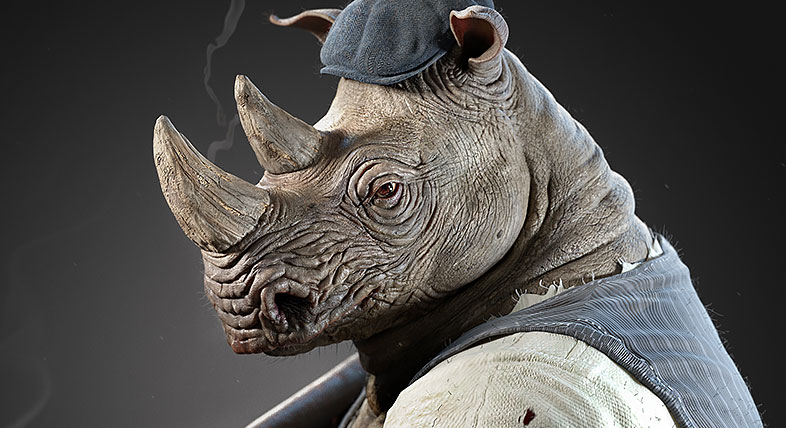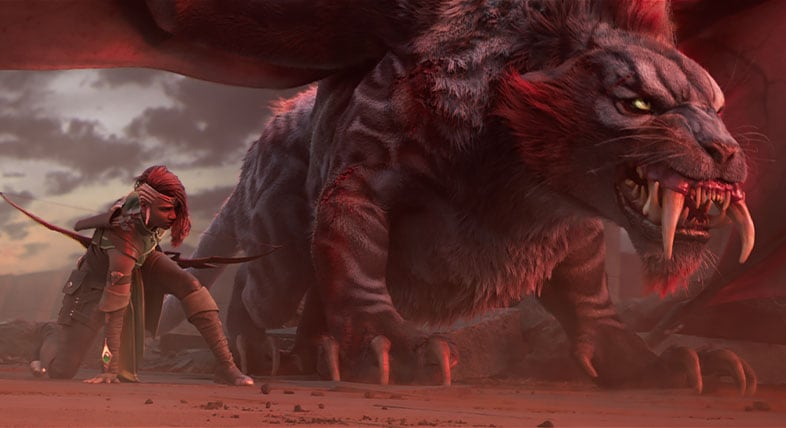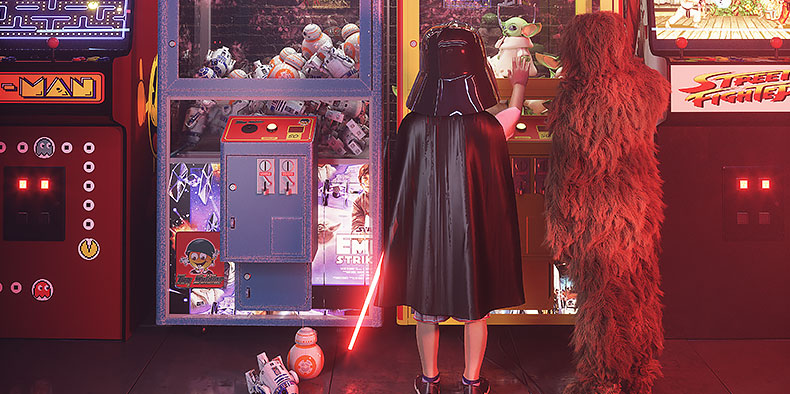Maya vs 3ds Max
When to choose Maya or 3ds Max
Maya and 3ds Max are used by creative studios around the world for animation, modeling, visual effects, and rendering
Maya vs 3ds Max
Maya and 3ds Max are used by creative studios around the world for animation, modeling, visual effects, and rendering

Maya is the professional 3D animation and visual effects software for film, TV, and games.
Image courtesy of Framestore

3ds Max is the professional 3D modeling, animation, and rendering software for games and design visualization.
Image courtesy of Thomas Berg

Whether you’re creating realistic digi-doubles or lovable cartoon characters, Maya offers you a robust toolset for shaping, grooming, and bringing your characters from concept to reality.
Image courtesy of Cinesite

From animating attributes of an object to transforming joints and bones, IK handles, and models over time, Maya gives you the creative freedom to bring your characters and scenes to life.
Image courtesy of Elizabeth Ku-Herrero

Bifrost makes it possible to create physically accurate and incredibly complex simulations in a single visual programming environment.
Image courtesy of Amid Rajabi
Polygon modeling in Maya allows you to create 3D models using geometry based on vertices, edges, and faces, while NURBS modeling enables you to construct characters from geometric primitives and drawn curves. Maya’s sculpting toolset provides an intuitive clay-like workflow for shaping and molding characters with full artistic control.
Interactive groom tools in Maya allow you to create realistic hair and fur for your beloved characters and creatures. Explore a full range of tools, including sculpting brushes, modifiers, and sculpting layers, dedicated to creating all styles of hair and fur.
Powerful tools in Maya speed up animation and editing. The Time Editor provides an intuitive, clip-based workflow for non-linear animation editing, so you can navigate easily between clips and adjust timing operations like speed, length, and start/stop times. Cached Playback enables you to evaluate iterations of your animation right in the viewport, rather than producing multiple playblasts.
From tools for producing high-quality, production-ready characters, to an intuitive graph editor for manipulating animation curves and keys, to shape authoring tools for adding fine details such as facial expressions, Maya makes it possible to bring lifelike movement to any scene or character you’re working on.
With a focus on bringing rich, procedural workflows to more areas of your pipeline, Bifrost includes powerful scattering, instancing, volumetric, and FX capabilities.
Using Bifrost, you can create detailed procedural effects like smoke, fire, explosions, sand, and snow, and easily share them with other artists to use across different shots, scenes, and shows. Effects can be previewed directly in the viewport and rendered with Arnold, the built-in renderer for Maya.

Westworld
See how the cutting-edge visual programming tools in Bifrost for Maya helped Korean VFX studio Westworld efficiently create out-of-this-world effects.
Image courtesy of Westworld

Rodeo FX
Watch Rodeo FX's Lead Rigger, Mathias Røyrvik, put Maya's latest rigging tools to the test on his Peaky Rhino character
Image courtesy of Damien Guimoneau

Axis Studios
Learn about the approach Axis Studios took to bring the behemoths to life in the latest Magic: The Gathering trailer.
Image courtesy of Axis Studio

3ds Max offers a rich and flexible toolset for easily modeling characters, props, and environments down to the finest details.
Image courtesy of Thomas Woodward

From rich wood surfaces to soft fabrics and lush greenery, add material finishes, textures, and realistic lighting that make your designs stand out.
Image courtesy of Alt Shift

3ds Max’s built-in renderer, Arnold, can handle your most complex scenes. Using intuitive controls, quickly iterate and see near-final quality renders right in the 3ds Max viewport.
Image courtesy of Vic Nguyen
3ds Max’s modeling toolset lets you shape and mold anything you set your mind to—from intricate details on characters and objects to jaw-dropping environments and worlds.
Using 3ds Max’s powerful polygon modeling tools, you can build complex models quickly. Tools like Smart Extrude offer an intuitive and flexible way for you to shape faces on an object and rebuild or stitch together adjacent faces automatically. Powerful retopology tools in 3ds Max enable you to create clean 3D topology and achieve professional results.
A unique modifier stack workflow helps you sculpt and edit. Use the Chamfer modifier to add edges, the Relax modifier to change surface tension, or the Symmetry modifier to perform common modeling tasks.
Step up your look development game with advanced texture-creation, material, and viewport tools in 3ds Max. Support for Substance maps and Open Shading Language (OSL) empower you to create and apply complex materials that bring your designs to the next level, while the Material editor lets you add material finishes, change textures, and use vibrant colors to create photorealistic designs.
Bake-to-texture in 3ds Max provides a streamlined, intuitive, and fully scriptable texture baking experience, with support for Physically Based Rendering (PBR), material input overrides, and OSL workflows.
3ds Max offers you the ability to see render previews quickly and efficiently, so you can spend more time being creative and less time waiting on time-consuming overnight renders. The 3ds Max viewport also offers render-quality previews, displaying physically based rendering (PBR) materials and camera effects directly.
With Arnold integrated as the default renderer, you can view scene changes in real-time, including lighting, materials, and cameras. And, thanks to support for Open Shading Language (OSL), you can edit OSL shader text directly in the material editor, and see live updates in the Viewport and ActiveShade, dramatically boosting productivity.

CGI Furniture
Learn how CGI Furniture uses 3ds Max to create photorealistic 3D product models for international clients looking to grow their business with CG imagery.
Image courtesy of CGI Furniture

Ubisoft
Adeline Aubame from Ubisoft Helix shares the tools her team used in 3ds Max to fast track the development of Rainbow Six Siege.
© 2015 Ubisoft Entertainment. All Rights Reserved. Tom Clancy’s, Rainbow Six, The Soldier Icon, Ubisoft and the Ubisoft logo are registered or unregistered trademarks of Ubisoft Entertainment in the U.S. and/or other countries.

Binyan Studios
Binyan Studios founder and CEO Andrei Dolnikov discusses crafting narrative experiences through design visualization, the latest industry trends, and why 3ds Max is his tool of choice.
Image courtesy of Binyan Studio
Create complex characters and dazzling effects using Maya’s robust toolset for modeling, shaping, grooming, rigging, and animating. Build expansive worlds and detailed props using 3ds Max’s easy-to-use and flexible toolset for modeling, texturing, shading, lighting, and rendering. Maya and 3ds Max are offered as part of the Media & Entertainment Collection. 3ds Max also comes standard across all of Autodesk’s industry collections.
From stylized to photorealistic characters, Maya’s modeling toolset lets you construct, shape, and sculpt 3D models artistically and intuitively. 3ds Max’s rich and flexible modeling tools empower artists to create massive environments and worlds.
Use 3ds Max to visualize high-quality architectural renderings and model finely detailed props and objects for your projects in less time. It offers a rich and flexible toolset to create premium designs with full artistic control.
Both Maya and 3ds Max offer a wide range of proven and established 3D tools for every step of the game development process. Maya’s robust animation toolset and unmatched rigging capabilities enable artists to breathe life into 3D characters and creatures. Powerful modeling tools and physically-based rendering in 3ds Max empower game makers to create expansive and detailed worlds for players to explore.
Maya’s Academy Award–winning animation toolset is used industry-wide to create believable characters and the worlds around them. Experience an intuitive and robust toolset that makes animating feel more like creative expression than pressing buttons.
Learn more about Maya and 3ds Max with these tutorials, guides, and tips.
Autodesk's official CG community. Watch free tutorials and get the latest industry news.
From modeling basics to diving into Bifrost and everything in between, get up to speed with this Maya course.
From finding your way around the interface to pipeline integration and everything in between, get up to speed with this 3ds Max course.
See how Maya has evolved. Over the years, Maya has delivered top-quality updates to help artists work faster. Learn how we continue to focus on creating artist-friendly experiences across disciplines.
3ds Max has provided artists with many updates over the years. See how we continue to deliver updates that improve performance and accelerate creative workflows for artists everywhere.